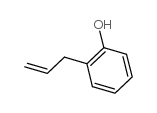Metabolism of fungicide 2-allylphenol in Rhizoctonia cerealis.
Tianli Qu, Jinlan Zhang, Zhaoli Meng, Xili Liu, Yongsong Cao, Jianqiang Li, Jianjun J Hao
文献索引:Ecotoxicol. Environ. Saf. 102 , 136-41, (2014)
全文:HTML全文
摘要
2-Allylphenol is a biomimetic synthetic fungicide that mimics the compound ginkgol found in gingko fruit (Gingko biloba L.). This systemic fungicide can effectively suppress a wide range of plant diseases, including wheat sharp eyespot (Rhizoctonia cerealis). However, its degradation in environment after application is still unknown. To understand this fungicide degradation, major metabolites of 2-allylphenol in R. cerealis were examined. The parent and metabolites of 2-allylphenol were detected and quantified in the mycelia and liquid medium. Results showed that 2-allylphenol was metabolized and bio-transformed by R. cerealis, and four metabolites were found, including 2-(2-hydroxyphenyl) acetic acid (M1), 2-(2, 3-dihydroxypropyl) phenol (M2), 2-(2-hydroxypropyl)-phenol (M3) and 2-(3-hydroxypropyl)-phenol (M4). Based on the results, we propose that the biodegradation pathway is that 2-allylphenol is rapidly oxidized into metabolite M2 and hydrolyzed into M3 and M4, which formed M2, and carboxylation of M2 to 2-hydroxy-3-(2׳-hydroxyphenyl) propionic acid which undergo hydrolyzation and decarboxylation to form M1. 2-Allylphenol can be bio-transformed to new compounds by R. cerealis, suggesting the existence of microbe metabolic pathways for 2-allylphenol. Copyright © 2014 The Authors. Published by Elsevier Inc. All rights reserved.
相关化合物
| 结构式 | 名称/CAS号 | 分子式 | 全部文献 |
|---|---|---|---|
 |
2-烯丙基酚
CAS:1745-81-9 |
C9H10O |
|
Inhibition of rat, mouse, and human glutathione S-transferas...
1996-01-05 [Chem. Biol. Interact. 99(1-3) , 85-97, (1996)] |
|
Isolation of an unusual metabolite 2-allyloxyphenol from a m...
2010-03-01 [Appl. Microbiol. Biotechnol. 86(1) , 109-17, (2010)] |
|
Inhibitory effect of bionic fungicide 2-allylphenol on Botry...
2009-12-01 [Pest Manag. Sci. 65(12) , 1337-43, (2009)] |
|
Male sex pheromonal components derived from methyl eugenol i...
2004-11-01 [J. Chem. Ecol. 30(11) , 2127-38, (2004)] |
|
Spectroscopic and theoretical studies on intramolecular OH-p...
2005-07-21 [Org. Biomol. Chem. 3(14) , 2620-5, (2005)] |